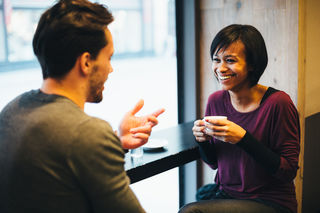Six Winning Body Language Techniques
Six Winning Body Language Techniques
Improve your communication skills and social life.

Source: Peter Bernik/Shutterstock
1. The Eyebrow Flash.
The eyebrow flash is that quick raising of the eyebrows that often occurs naturally when you see someone you know. It is almost imperceptible, but it can still have an important effect on others. The eyebrow flash can be used as a quick and casual greeting, and can defuse a situation in which someone might perceive you as potentially threatening.
2. Touch.
A great deal of research suggests that a light touch can establish a connection. For example, in studies waiters who lightly touch a customer when presenting the bill receive higher tips. Of course, a touch can also be used to signal sexual interest. (Learn more about the power of touch.)
3. Enter the Bubble.
We all carry with us a bubble of personal space. A personal space invasion causes arousal. Invading someone’s bubble can have different motivations – as a threat or to signal intimacy – but it will nearly always catch the other person off guard.
4. The Power of Eye Contact.
Like a personal space invasion, eye contact can be used to cause arousal, either as a threat or as an entreaty, and it is a very subtle, but powerful cue. (Learn more about the secret powers of eye contact here.)
5. Duchenne Smile.
Research by Paul Ekman and colleagues differentiated “fake” smiles from true, or “Duchenne,” smiles. A fake smile can easily be interpreted as such by others, to your detriment. The key to a true smile is the narrowing of the eyes, and the wrinkles, or “crow’s feet,” at the outer corners. You can portray a Duchenne smile if you practice, and your nonverbal smile will seem more authentic to others. (Learn more about smiles here.
6. Nonverbal Greetings.
Greetings can help set the tone for an interaction. For example, in a job interview or business meeting, it is usually a good idea to have a firm handshake, indicating that you are both serious and alert. If you seek a more intimate interaction, a two-handed handshake conveys that you care for and/or appreciate the other person. Hugging suggests greater intimacy, but hugs can vary greatly and be interpreted in a variety of ways. Pay attention to your greetings, because they are important, can convey different messages, and help to create a more effective social interaction.

